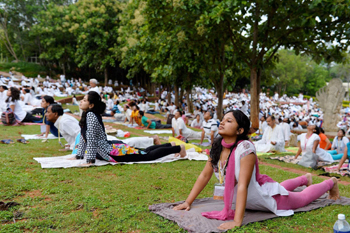New Delhi, May 25: As it gears up for Mega Yoga Day celebrations, the government has plans to declare a hundred parks especially dedicated for yoga activities across the country to promote this traditional practice.
Uttar Pradesh capital Lucknow will host the main event of the International Day of Yoga (IDY) on June 21 this year where Prime Minister Narendra Modi will participate.
Around 150 countries are expected to participate in the mega event, with Indian Missions in those nations coordinating the activities. IDY will be observed at some of the major landmarks like the Eiffel Tower in Paris, the Trafalgar Square in London and the Central Park in New York among others.
"It would be no exaggeration to say that the world has acknowledged the supremacy of India in the field of yoga. Last two years, the IDY was celebrated across the globe with an active participation of more than 190 countries," Minister of State for AYUSH Shripad Yesso Naik said.
The Prime Minister’s Award for outstanding contribution to promotion and development of Yoga at the national and international level will be given to individuals or organisations who have made a significant impact on the society for a sustained period of time by way of promotion and development of Yoga, Naik said.
A screening committee chaired by AYUSH secretary has been constituted to recommend the names and the jury headed by Cabinet Secretary will finalise the four winners, two in each category.
The ministry is also planning to have 100 Yoga parks across the country which will be managed by Yoga or other organisations voluntarily.
The prime minister, senior ministers, Uttar Pradesh chief minister and yoga gurus along with nearly 51,000 people are expected to take part in the event.
In Delhi, seven main events are being planned in different places in association with NDMC, DDA and Yoga organisations.
Apart from this, yoga events will be held in different parts of the country as well as main cities like Paris, London and New York across the globe.
The Ministry on its official website has requested the people visiting the web page related to IDY to take a pledge to make yoga an integral part of their daily life.
The first IDY celebration was organised at Rajpath in New Delhi on June 21, 2015, in which representatives of 191 countries had participated. Last year, the main function was in Chandigarh.
The United Nations General Assembly, heeding to a call by Prime Minister Modi, had made a declaration in December 2014 to observe June 21 every year as IDY.





Comments
Add new comment